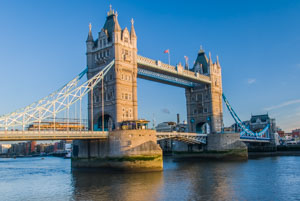Probably the most useful transportation method for the visitor to London is the tube, or Underground. The London Underground can be properly said to have begun in 1890 when an electrically-powered line was opened between King William Street and Stockwell. There are now 12 lines plus the Docklands Light Railway serving millions of travellers around London every day.
Although the tube will usually be the quickest and most inexpensive way of getting about London (that is, if you take advantage of the various discount passes available), be aware that the British Rail "above-ground" trains serve some areas of London better than the tube (details here).
Maps
The colour-coded London Underground map is a familiar sight to travellers. It really is quite simple to follow, but when planning a journey please be aware of the number of transfers your journey will take. Many stations contain miles of corridors and numerous staircases, which can make travelling with heavy suitcases a real chore. A longer journey with fewer transfers between lines will be less troublesome if you are carrying down with luggage.
To study a copy of the London Underground map at a larger size than the one here, click here (caution, this image from the London Transport web site is large and takes some time to load).
North Americans beware: the term "subway" in Britain refers to an under-the-street pedestrian walkway - NOT the Underground train system!.
Underground map courtesy of Transport for London.
Regular underground service runs from 0530 to just after midnight. The gap in service during the night is bridged by a night bus service.
Tickets
You can buy tickets either from automated machines or at a ticket window. You will need to keep your ticket until you have passed through the gates at your destination station. Be aware that ticket inspectors randomly police the Underground and can (and will) levy sizeable fines for invalid tickets.
Avoid the weekday rush hours if at all possible. Underground traffic is heaviest between 0800 and 0930, and between 1600 and 1830. Be aware that most discount passes, such as the London Visitorcard, are not valid for morning rush-hour travel.
Travelcards
The TravelCardis good for unlimited travel on both the Underground and the buses. Travelcards can be purchased for 7 days or more at a time.
Visitorcards
Another option, the Visitor Oyster Card, is geared towards visitors to the UK. In addition to unlimited bus and Underground travel these cards include discount vouchers for many popular tourist attractions.
If you live in the US, London Visitorcards are also available for AAA members from AAA offices. Save yourself time by getting yours before you go.
Zones
Greater London is divided into 6 transit zones. Anytime you travel beyond one zone the fare rises. You can save money by only buying as far-ranging a Travelcard as you'll need, but do not try to use a pass to go to a zone you are not authorized for! You'll be liable for the GBP10 fine mentioned above, and inspectors DO check.
Take a good look at the zones on a transport map (available free at any tube station or at the London Transport web site). Most of the major tourist attractions are located in Zone 1, so you're fairly safe with a Zone 1 or a Zone 1-2 card. However, be sure to check the location of your hotel against the fare zone map. If your hotel is out in zone 6 and you will be travelling to Inner London, you'll need an all-Zone Travelcard.
Travelcards come in a bewildering variety of options. These are sample prices current in 2016. For up to date prices, visit the London Transport web site.
Travelcard Fares (subject to change!)
Weekly TravelCard
Adult Zone 1 - £32.10
Adult Zone 1-6 (ALL-Zone) £58.60



